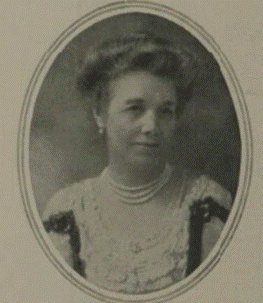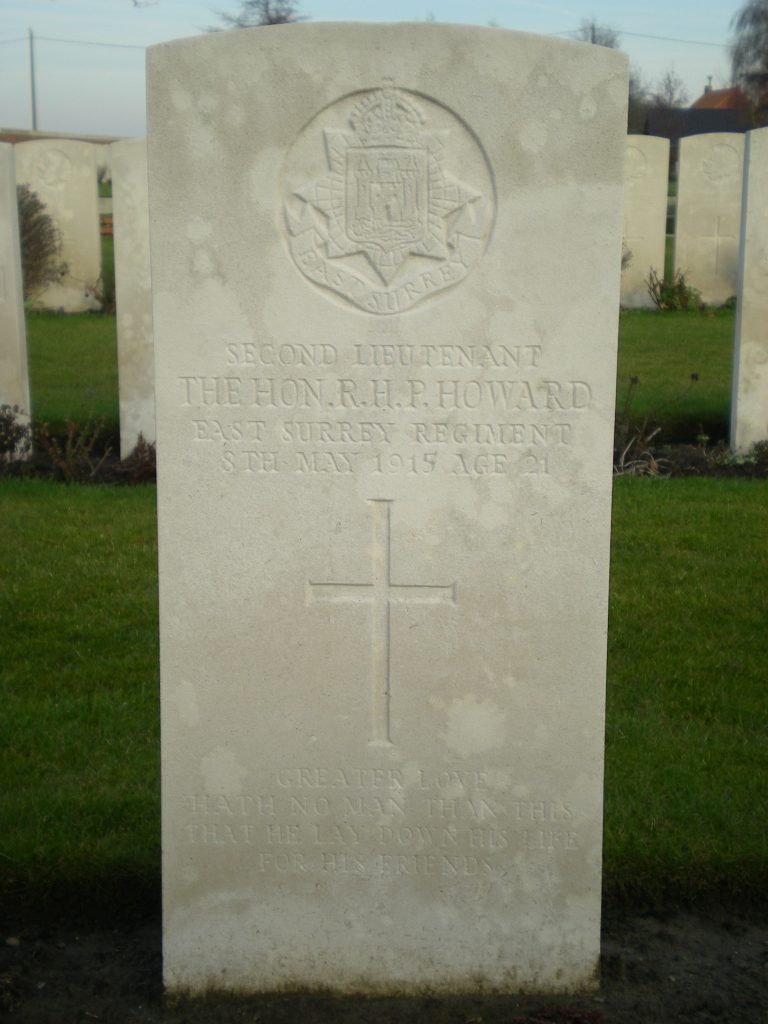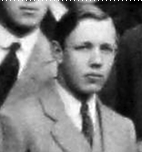Fact file:
Matriculated: 1911
Born: 22 September 1893
Died: 8 May 1915
Regiment: East Surry Regiment
Grave/Memorial: Potijze Château Lawn Cemetery: E.27.
Family background
b. 22 September 1893 as the second son (of five children) of Robert Jared Bliss Howard, MD, FRCS, OBE (1859–1921) and Baroness Strathcona and Mount Royal (Margaret Charlotte Howard, née Smith, 1854–1926) (m. 1888), Glencoe House, South Ballachulish, co. Argyll, Scotland. At the time of the 1901 and 1911 Census the family lived at 31, Queen Anne Street, London (10 and 9 servants respectively); they were later at 28, Grosvenor Square, London W1, and 46, Green Street, Park Lane, London W1.
Parents
Howard’s father was the son by his first marriage of Professor Robert Palmer Howard (1823–89), the most eminent doctor in Montreal and a Professor of Medicine at McGill University.

Professor Robert Palmer Howard (1823-89), Howard’s grandfather
Robert Jared graduated at McGill with a first-class degree in Natural Science (1879) and was awarded the Faculty’s Gold Medal for overall excellence (1882). He then studied at the London Hospital (MRCS and LRCP, 1882), and here, in 1884, he became the first Canadian to be awarded the FRCS. He subsequently studied in Berlin, Vienna and Leipzig and for some years he was in practice with his father in Montreal, where he also worked as Demonstrator in Anatomy and Surgery at McGill University and as a pathologist and assistant surgeon in the Montreal General Hospital.
After their marriage in 1888, Robert Jared and his wife moved to London, where he practised as a laryngologist and worked in the Guards’ Hospital during the Second Boer War. But after some years, his wife’s family’s wealth enabled him to move away from medicine and devote himself to country pursuits, especially shooting and fishing. During World War One, he organized the Mount Royal Hospital for Officers at Bath and also worked in the 3rd London General Hospital, Wandsworth, London SW18.

Robert Jared Bliss Howard

Margaret Charlotte Howard, Baroness Strathcona
(Illustrated London News, no. 3,902, 31 January 1914, p. 8)
The obituarist of Howard’s mother characterized her as a “kindly, generous, and single-minded” person who “found her greatest happiness in the quietness of her home life and the upbringing of her children”. But this domestic miniature occludes the fact that Margaret Charlotte was the only child of Donald Arthur Smith (1820–1914), 1st Baron Strathcona (a Gaelic variant of Glencoe) and Mount Royal in the Province of Quebec and Dominion of Canada and of Glencoe in the County of Argyll, and Isabella Sophia Smith (née Hardisty) (1825–1913).

Randall Thomas Davidson (1848–1930, Archbishop of Canterbury), the 1st Baron Strathcona and Mount Royal (1820–1914), Andrew Carnegie (1835–1919) and John Marshall Lang (1834–1909, Principal of Aberdeen University) receiving Honorary Degrees, Aberdeen University, 1900
(© National Portrait Gallery, London)

Isabella Sophia Smith (Lady Strathcona) (1825–1913)

Donald Arthur Smith (later Lord Strathcona) drives in the last spike of the Canadian Pacific Railway on 7 November 1885 at Craigellachie, British Columbia, Canada
Donald Arthur Smith was an immensely wealthy and highly controversial businessman (fur trader, financier and railroad builder) and politician, “one of the great makers of modern Canada” who, having emigrated to Canada from Scotland in 1838 and joined the Hudson’s Bay Company as an apprentice clerk in the same year, worked his way up to become its principal shareholder and Governor in 1889; his wife was the daughter of the Company’s chief factor. In 1896, Smith became High Commissioner for the Dominion of Canada in London, a diplomatic post that he held until his death. He was knighted in 1896 and ennobled in 1897, and during the Second Boer War he raised and equipped Strathcona’s Horse at his own expense (over $1,000,000). A notable philanthropist, it is estimated that he gave away over $7,250,000 in donations and bequests: it was he who secured the “Turbutt Shakespeare” for the Bodleian in 1906 (see G.M.R. Turbutt) and he took a special interest in McGill University, which is, however, not how Robert Jared Howard came to meet his daughter.
It appears that during one hard Montreal winter, Robert Jared found Margaret Charlotte Smith in her overturned horse-drawn carriage, rescued her, and attended to her injuries. As Lord Strathcona’s wife was an invalid, Margaret Charlotte increasingly acted as her father’s hostess at official functions, and on 24 April 1900 the Queen granted her a patent that allowed her and her male descendants to succeed to the barony (i.e. become peers in their own right). Her father left $28,867,635 ($26,500,000 in trusts for his heirs and successors), of which she inherited £500,000 (approximately £29,000,000 in 2005) together with seats in Glencoe and Colonsay, Debden Hall, Essex, and a residence in Montreal. Lady Strathcona was not only an able assistant to her father, she was also, like her father, a philanthropist. When, in 1919, the City bank of McGrigor failed – mostly because of loans to serving soldiers in the British Army who were subsequently killed in action, Lady Strathcona, a friend of the McGrigor family, paid off all the creditors and thus saved McGrigor himself from going to prison.
Siblings and their families
Brother of:
(1) the Hon. Frances Margaret Palmer (1889–1953); later Kitson after her marriage in 1913 to Lieutenant-Commander James Buller Kitson, RN (later Captain RN, DSO) (1883–1976); one daughter;
(2) the Hon. Donald Sterling Palmer, later the 3rd Baron Strathcona and Mount Royal (1891–1959); married (1922) the Hon. Diana Evelyn Loder (1899–1985), daughter of the 1st Baron Wakehurst; four children;
(3) the Hon. Edith Mary Palmer (MBE in 1941) (1895–1979); later Parnell after her marriage in 1918 to John Brooke Molesworth Parnell, BSc (McGill), MIME (later the 6th Baron Congleton) (1892–1932); nine children; then Aldridge after her marriage in 1946 to Flight-Lieutenant Eric Rowland Aldridge (1898–1950); later Congleton after changing her name by deed poll (1951);
(4) the Hon. Arthur (later Sir) Jared Palmer (JP, KBE in 1953, CVO in 1937) (1896–1972); married (1922) Leonora (Lorna) Baldwin (1896–1989), the second daughter of the Conservative politician Stanley Baldwin (1867–1947), Prime Minister from 1923 to 1929 and 1935 to 1937); four children.
All four of Howard’s siblings played an active part in World War One, married well and/or were prominent in public affairs.
Howard’s two brothers fought in the war and survived. Donald Sterling, who had studied at Trinity College, Cambridge, was a Captain in the 3rd Hussars in France throughout the war and won the Belgian Croix de Guerre. Until he inherited the title from his mother, Donald Sterling was the Unionist MP for North Cumberland (1922–26) and Parliamentary Private Secretary to the First Lord of the Admiralty (1925–26). After that, he was a member of the Indian Statutory Commission (1927–30), the Director of the Primrose League (1930–31), the Captain of the King’s Bodyguard of the Yeoman of the Guard (1931–34), the Parliamentary Under-Secretary of the Secretary of State for War (1934–39), the Chairman of the Committee of Inquiry into the administration of the Army (1937), a member of the Army Council with special responsibility for the Territorial Army, and a serving officer once more in World War Two.

Donald Sterling Palmer Howard, 3rd Baron Strathcona and Mount Royal, by Walter Stoneman; bromide print, 1923
(NPG x162245, © National Portrait Gallery, London)
© National Portrait Gallery, London
During World War One, Edith Mary worked with the Voluntary Aid Detachment in the Lost, Wounded, and Found Office of the British Red Cross, which published the official frontline news in the press. She later became a Member of Hampshire County Council, the Chairman of New Forest Rural District Council, and a JP (1948–56).
According to one of his nieces, Howard’s younger brother, the Hon. Arthur Jared, spent a mere three weeks at Magdalen before volunteering. Although he was so short-sighted that the Army turned him down initially, special glasses and family influence ensured that he was eventually passed fit and commissioned into the Scots Guards on 7 March 1915. He said that his short sight was a big disadvantage since he had to wait until a German was very close before he could be sure and shoot: perhaps not surprisingly, he was wounded four times, once seriously in the stomach. Arthur served in France from 1915 to 1917, rose to the rank of Captain, may have been mentioned in dispatches in 1917, and was awarded the Croix de Guerre. He was later elected Conservative MP for the St George’s Division of Westminster (1945–50) and served as the Treasurer of St Thomas’s Hospital (1943–64).
Education
Howard attended Fonthill Lodge Preparatory School, East Grinstead, Surrey, from 1902 to 1907. (The school was founded in 1808 and closed in 2011; cf. A.H. Huth, J.R. Somers-Smith). It was also known as Mr Radcliffe’s in the last quarter of the nineteenth century because of its proprietor Walter William Radcliffe, 1847–1923.) He then attended Eton College from 1907 to 1911, during which time he was elected a Fellow of the Royal Botanic Society on 28 February 1910. He matriculated at Magdalen as a Commoner on 17 October 1911, having passed Responsions in Hilary Term 1911. He took the First Public Examination in the Hilary and Trinity Terms of 1912 and then began to read for a Pass Degree (Groups A1 [Greek and/or Latin Literature/Philosophy], B3 [Elements of Political Economy], and B4 [Law]) in the Trinity and Michaelmas Terms of 1913. But in Trinity Term 1914 he was awarded a 3rd in Modern History (Honours) and he took his BA on 11 July 1914.
His Eton obituarist wrote:
He did not attain to full prominence in the School, as he left early in order to be able get through his University career in time to acquire a knowledge of modern languages for the Civil Service examination. But in his House, he was, like his brothers, well known and appreciated. […] He was a boy of much promise. He had sound abilities and quiet resolution, qualities which were to have fitted him for good work in England, when he should be a man, and which qualified him for a soldier’s life and a gallant death.
President Warren wrote of him posthumously: “Quiet and modest and a little diffident of his own abilities, which were in fact very good”, he intended, on graduation, to
go abroad and study for the Foreign Office. There he might well have had a fine career, for he had excellent sense and admirable temper and a quiet way of winning confidence, esteem, and liking with men of every age and sort.
It was probably during Howard’s time at Oxford that President Warren tried to persuade his grandfather, Lord Strathcona, to fund a Chair of French. He was, however, not successful and the Maréchal Foch Chair of French was later founded in 1919 by the arms dealer Sir Basil Zaharoff (1849–1936). When making his will, Howard gave his address as 28, Grosvenor Square, London, and it was here that J[ohn] Brett Langstaff (later the Revd Dr) (1889–1985), an American B. Litt. student at Magdalen, met him in Michaelmas Term 1914 while he was on a visit to his particular friend, Howard’s brother Arthur. Langstaff later described Howard as “the sort of man men admire, and is well remembered here at Magdalen.”

The Hon. Robert Henry Palmer Howard, BA
(Courtesy of Magdalen College Oxford; detail from a group photograph, Summer Term 1912)
Military and war service
Howard, who was 5 foot 11 inches tall, joined the Oxford University Officers’ Training Corps during his first term at Magdalen, served as an officer cadet for three years and then passed Certificate ‘A’. On 7 August 1914, i.e. shortly after the outbreak of war, he applied for a Commission in the Special Reserve of Officers and a week later, on 15 August, he was commissioned Second Lieutenant on probation in the 4th (Extra Reserve) Battalion, the East Surrey Regiment (London Gazette, no. 28,876, 21 August 1914, p. 6,599). On 24 December 1914 he wrote to President Warren, telling him of this fact and adding: “but [I] am seconded for service [at Hounslow Barracks, Middlesex, in the Army Cyclist Corps]. There are one or two old Magdalen men in my battalion, including two Huths & a nice chap, called Norton – all rather older than myself.”
Howard was subsequently brought back to the East Surrey Regiment and transferred to its 2nd (Regular) Battalion, which he joined on 3 May 1915, when it was in line near Verlorenhoek, in the Ypres Salient. When war broke out, the 2nd Battalion had been on garrison duty in Chaubattia, Northern India, but it embarked for England in late November 1914, landed at Devonport on 23 December, and then travelled to Winchester, where it became part of 85th Brigade, in the 28th Division. The Battalion crossed to Le Havre on 19 January 1915 and on February 1915 began to serve in the trenches near Ypres, where, over the next three months, it suffered heavy casualties, especially between 23 April and 8 May during the Second Battle of Ypres (23 April – 8 May 1915), when it lost well over 600 men killed, wounded and missing.
After Howard reported for duty with the 2nd Battalion, it rested for three days in billets east of Poperinghe, and then, on 8 May 1915, left at 11.00 hours to take up positions astride the Ypres to Zonnebeke Road. Here it was ordered to retake the 83rd Brigade’s trenches at Frezenberg, north-east of Ypres. The Battalion advanced at 16.00 hours, but on reaching the road running south-east from Wieltje, it came under machine-gun fire from the farm on the left. As a result, it was held up in front of Verlorenhoek after taking 178 casualties killed, wounded and missing, including Howard, aged 21, who was picked off by a sniper. He is buried in Potijze Château Lawn Cemetery, north-east of Ypres, in Grave E.27; the inscription reads: “Greater love hath no man than this that he lay down his life for his friends” (John 15:13; see also C.R. McClure, J.W. Lewis, G.B. Gilroy, R. Roberts, E.G. Worsley, A. Tait-Knight and J. Fox Russell). He is commemorated on the Glencoe War Memorial and the Memorial inside St Mary the Virgin and All Saints Church, Debden, Essex, for all “the men from this Parish” who died in the war; and a memorial service was held at St Mark’s Church, North Audley Street, Mayfair, London W1, on 19 May 1915. His sisters Frances and Edith both called their sons “Harry” in his memory. He died intestate, but his estate, which went to his father, was valued at £9,748 10s 4d.

Potijze Château Lawn Cemetery (north-east of Ypres); Grave E.27

The Memorial inside St Mary the Virgin and All Saints Church, Debden, Essex
(© John Salmon, contributor to the Geograph Project, and licensed for re-use under this Creative Commons Licence)
Bibliography
For the books and archives referred to here in short form, refer to the Slow Dusk Bibliography and Archival Sources.
Special Acknowledgement:
**Donna McDonald, Lord Strathcona: A Biography of Donald Alexander Smith (Toronto and Oxford: Dundurn Press, 1996).
Printed sources:
[Thomas Herbert Warren], ‘Oxford’s Sacrifice’ [obituary], The Oxford Magazine, 33, no. 20 (21 May 1915), pp. 320–21.
[Anon.], ‘Robert Jared Bliss Howard, M.D. McGill, F.R.C.S. Eng.’ [obituary], British Medical Journal, no. 3,133, part 1 (15 January 1921), p. 105.
Pearse and Sloman, ii (1923), pp. 87–102.
[Anon.], ‘Obituary: Lady Strathcona’, The Times, no. 44,354 (19 August 1926), p. 12.
Laurie Magnus, Herbert Warren of Magdalen: President and Friend 1853–1930 (London: John Murray, 1932), pp. 9.
[Anon.], ‘Lord Strathcona and Mount Royal’ [obituary], The Times, no. 54,392 (23 February 1959), p. 10.
J[ohn] Brett Howard (1965), p. 143.
[Anon.], ‘Sir A. Howard’ [obituary], The Times, no. 58,157 (27 April 1971), p. 18.
Leinster-Mackay (1984), pp. 26–7, 114, 245, 328.
Archival sources:
MCA: PR32/C/4/703-4 (President Warren’s War-Time Correspondence, Letters relating to the Hon. R.H.P. Howard).
MCA: Ms. 876 (III), vol. 2.
OUA: UR 2/1/75.
WO95/2279.
WO339/24424.
On-line sources:
Alexander Reford, ‘Smith, Donald Alexander, 1st Baron Strathcona and Mount Royal’, Dictionary of Canadian Biography, vol. 14 (University of Toronto/Université Laval, 2003– ): www.biographi.ca/en/bio/smith_donald_alexander_14E.html (accessed 9 January, 2019).
